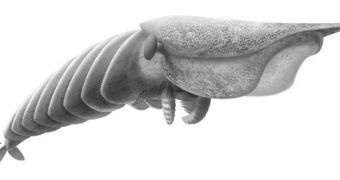The UNESCO World Heritage Site Burgess Shale, in the Canadian Rockies of British Columbia, is home to one of the greatest sources of fossils from the Cambrian Age. Complex and well-preserved remains are constantly excavated from this location, and one of the digs seems now to hold a big surprise for its discoverers. Apparently unrelated fragments now combine to offer the first glimpse of a completely new species of marine predators, which roamed the seas some 505 million years ago.
The 0.5-meter (1.5-foot) -monster was not big by today's standards, when compared for example to a whale, or to another dinosaur monster, Predator X. But it was remarkable precisely because of its size. The beast, known as Hurdia victoria, was first described more than 100 years ago, though researchers at the time believed that the tiny fragments they had found actually originated from crustacean animals, such as jellyfish, sea cucumbers and other arthropods.
It was only recently that investigators realized that the tiny bone fragments actually fitted together to create one of the most unusual marine predators of all times. Its head had a pair of tiny claws, whose functions are still guessed, and it's entire body was segmented. On the head, it sported a jaw-like structure adorned with numerous teeth, most likely used to rip its prey apart before eating it.
“Finding a complete fossilized animal is extremely rare. Soft tissues tend to decay rapidly after death, and harder parts tend to disarticulate or break into pieces, often leaving very few clues as to what the original animals looked like,” Royal Ontario Museum expert Jean-Bernard Caron, who looks after many fossils uncovered at Burgess Shale, including some pieces from the Hurdia victoria, explains.
The creature also possessed a three-segmented shell at the front of it's head, a formation that was highly unusual and that has had scientists thinking as to its origins. “It was hard to tell whether the box-like shell structure came to lie so far forward after the animal died, or when it molted its hard parts, or if this was how it really looked when alive. The way the fossil is preserved made us decide that it really had this structure in front of its head, but we still don't know what it was for,” Natural History Museum paleontologist Greg Edgecombe wonders.
“In many animals, a shell or carapace is used to protect the soft-parts of the body, as you would see in a crab or lobster, but this structure in Hurdia is empty and does not cover or protect the rest of the body. We can only guess at what its function might have been,” Swedish scientist Allison Daley, from the Uppsala University, tells LiveScience in an e-mail. She has been the leader of the research team that has investigated the Hurdia victoris remains, and has also worked with the fossils for her doctoral thesis.

 14 DAY TRIAL //
14 DAY TRIAL //